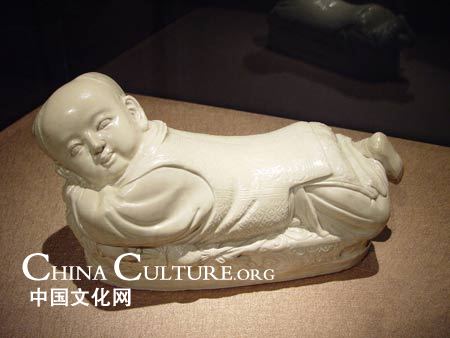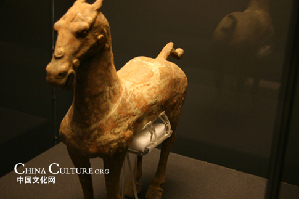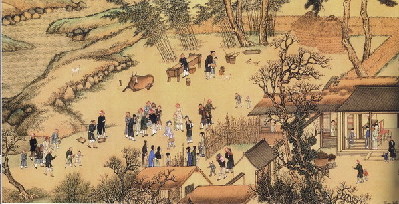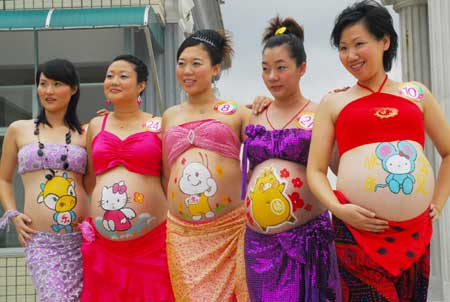| Home > Living in China > Art |
A Cultural Symbol - China"s New Year Picture

Spring Festival, China's most celebrative occasion, begins its annual felicitations with the posting of New Year pictures on the walls and windows on the 24th of the 12th month in the lunar calendar according to tradition. The pictures convey people's jubilation and expectations of the coming new year.
However, in a century of rapid globalization, how many traditions have been lucky enough to survive? Is the New Year picture bound to disappear from people's memory?
Traditional New Year pictures mainly feature local people's life and customs with intense colors and violent contrast. Famous pictures like "Fat Baby," "Abundant Harvest of All Food Crops," and "Surplus Every Year" have been prevailing across China for hundreds of years. Nonetheless, today, these pictures can hardly be found in some modern metropolises like Shanghai, which was once a prosperous place for New Year picture manufacture and consumption. Some think that the disappearance of New Year pictures is unavoidable. So what remains beneath the continuing disappearance?

Epitome of traditional customs:
Chinese New Year pictures not only serve mainly as an embodiment of folk customs, but also boast decorative and appreciative values. "People post these pictures around the walls of the kang (a heatable brick bed in North China) and on the windows for ornament. The pictures' contents include folk tales, ancient legends, historic stories, and real life scenarios, and thus boast appreciative value," noted Feng Jicai, a famous writer as well as the president of the China Folk Artists Association that is dedicated to rescuing China's folk culture, including the investigation and rescue project of woodblock.
New Year pictures from Tianjin Yangliuqing, Suzhou Taohuawu, Weifang Yangjiabu, and Hebei Wuqiang are acknowledged as the "Four Great Woodblocks in China," each of which boasts unique features. Nonetheless, the four places of New Year's picture production have been gradually declining since the 1980s, and are at the verge of extinction.
"In fact, Chinese New Year pictures began to disappear as early as the beginning of the Republic of China (1911-1949)," said Feng, adding: "Shanghai clearly demonstrated the disappearing trace of New Year pictures." Su Zhou Taohuawu New Year's pictures entered the Shanghai market at the beginning of the Republic of China, and over time evolved into Xiaoxiaochang New Year pictures. "They (Xiaoxiaochang New Year pictures) reflected the life in the concessions, echoing the time spirit and containing local flavor," said Feng. "But the introduction of Western printing skills changed the fate of China's New Year pictures. ?However, the New Year pictures with new printing skills do not have the original and traditional flavor."

In Wuqiang County of North China's Hebei Province, there are only about 80 experienced artists with an average age of 40 engaged in cutting woodblocks and printing New Year pictures. Many seasoned craftspeople changed their profession when the industry began to decline. Although now, many famous places that produce New Year pictures have developed the place's culture and tourism with the support of woodblock, hence greatly enhancing the artworks' popularity and protection, with its root no longer in the traditional customs, Wuqiang's original flavor has weakened. "The disappearing course of China's New Year pictures is also a process in which we throw away our traditions," noted Feng. "We could only really pick up New Year pictures again by meditating upon history, folk customs, and cultural bearings." Spring Festival is usually mentioned in the same breath as Christmas. While China has fireworks and New Year pictures, the West boasts Christmas trees, Santa Claus, and Christmas cards.
"In the transition from an agricultural civilization to an industrial one, Westerners have better learned how to adapt history and local flavors to the context of modern society. But the literati and artists did not do well in this transitional process. They should have actively and initiatively incorporated Chinese folk customs like the New Year pictures to the modern way of living," said Feng. The significance of the New Year pictures is to embody people's psychology, willingness, and diverse pursuits of traditional Chinese New Year events, Feng added.
The significance of the New Year pictures is to embody people's psychology, willingness, and diverse pursuits of traditional Chinese New Year events, Feng added.

The New Year picture is a kind of unique painting form that is closely related to the New Year customs. It originated from the peach wood charms hung on the gate early in the Zhou Dynasty (about 11th century-256BC) as part of the Spring Festival celebrations and activities to drive away the evil spirits. The peach wood gradually evolved into writings and paintings as couplets and Door God paintings -- a precedent of the New Year picture -- respectively. In the Sui (581-618) and Tang (618-907) dynasties, New Year pictures experienced rapid development. Mundane figures like young maids and Buddhist figures were also added to the paintings that were to hang on the door. To the Northern Song Dynasty (960-1127), New Year pictures gradually matured with the development of the commercial economy as well as the citizen culture, providing a huge market. The wide use of engraving painting skills established a solid foundation for the development of New Year pictures. During this period, specific markets and workshops appeared, and New Year pictures evolved into an independent art form. In the Ming (1368-1644) and Qing (1644-1911) dynasties, New Year pictures flourished and production centers were established throughout the country. Also, while the art form matured in the Song Dynasty, the name "New Year picture" appeared only the late Qing Dynasty. New Year pictures are a folk art form with the most distinctive of local features. Different cultures and different folk customs gestated various colorful New Year pictures. Environmental and customary differences contributed to various local flavors in color, pattern, picture formation, and function.

The Taohuawu New Year picture in Suzhou of East China' Jiangsu Province is the most popular of its kind south of the Yangtze River. Beginning in the Ming Dynasty and flourishing in the Qing Dynasty, it is as famous as its counterpart, the Yangliuqing New Year picture in North China's Tianjin Municipality. Hand paintings were sold at the beginning, before gradually developing into multi-color woodblock printings. The artworks boast high decorative values, and the painting style influenced Suzhou's neighboring regions like Hangzhou and Shanghai.
Mainly featuring dramatic stories, classic novels, and local people's life and customs, Taohuawu New Year pictures are known for their delicate carving and exquisite making process. By the late Qing Dynasty, the art form assimilated some skills of Western painting, making Taohuawu New Year pictures more "realistic" in style.

Yangliuqing is located near the waterway and land transportation pivot of Tianjin, and not far from Beijing. Wood blocks in the region rose at the juncture of the Ming and Qing dynasties, and bloomed during the reign of Qing Emperor Qianlong. A saying goes that "every household can add details to a painting, and everyone is good at colors."
Yangliuqing New Year pictures prevail in North China, influencing almost all the other New Year pictures in the region. Figure painting is a very important part of Yangliuqing New Year pictures, with the fat baby maid pictures beign especially popular. In fact, Yangliuqing New Year pictures were the inspiration of Friendly Beibei, one of the 2008 Beijing Olympic mascots.
Yangliuqing New Year pictures combine woodcarving, watermarking, and color painting, retain the techniques of folk paintings, and are influenced by the Qing painting workshops. Its subjects mainly include drama stories, beautiful women, and plump moppets, as well as josses, door gods, images of beauties, boy and girl attendants to a god or goddess, auspicious pictures, birds and beasts, flowers, water and mountain landscapes, and characters from dramas and legends. However, festivity and auspiciousness are always the main themes of Yangliuqing New Year Pictures.
Yangliuqing New Year pictures combine delineation, woodcarving, overprinting, color painting and mounting techniques, while featuring an exquisite touch, smooth lines, elaborate techniques, lifelike color paintings, and a vivid luster, especially the color paintings of human faces, which are fine, bright, and true to life.

Shandong Yangjiabu New Year pictures
Liaocheng's Yangjiabu presents New Year pictures in East China's Shandong Province. The artworks mainly feature Buddha and various other gods in an unconstrained manner. Yangjiabu New Year pictures reached a considerable scale in the Ming Dynasty. These pictures were also influenced by the Yangliuqing style, causing their subjects to later widen greatly, while at the same time maintaining their original flavor of being unsophisticated and vivid, forming their own unique style.
Shandong's New Year pictures as well have a rich content, with a lot works reflecting the rural life. The collocation of colors is usually exaggerated, bold, intense, and violent in contrast. The wild lines also add a special of farmer's painting to the art form.

Prevailing mainly in North China, the Wuqiang New Year picture got its name because it was mainly produced in Hebei Province's Wuqiang County. The overprint wood block skills usually include three procedures of painting, carving, and printing. The subjects usually include opera stories, folkways, fashion, festival, marriage, moppet, beauties, flowers, and landscapes.
Sichuan Province's Mianzhu region teems with high-quality tissue paper, which provides good raw material for the production of New Year pictures. At the end of the Ming Dynasty and the beginning of the Qing Dynasty, Mianzhu New Year pictures began to flourish, and the place became a large manufacture base for New Year pictures in Southwest China.
The Zhuxianzhen New Year picture also got its name as it is mainly produced in Zhuxianzhen Village near Kaifeng of Central China's Henan Province. The place began to produce New Year pictures in the Song Dynasty, and prospered in the Ming and Qing dynasties.
Famous writer Lu Xun once highly lauded the New Year picture produced in the place, saying: "The carving lines of Zhuxianzhen wood blocks are very macho; it's not elaborately polished, very unlike those in other places. The wood blocks are simple, with no extra adornment. The figure painting has very strong color, without being overbearing. The strong local flavor is typical of wood blocks in North China."
Foshan New Year's pictures, produced in Guangdong Province's Foshan, are popular in South China. There are basically three kinds of New Year pictures in Foshan: original painting, wood block, and wood block with realistic painting. The high decorative function is the unique feature of Foshan New Year picture.
Art
 more
moreClassic Chinese Handicraft:
Porcelain pillows, as classic Chinese handicraft,

Chinese Treasures Returned from
As witness of Chinese culture and custom, countless treasures

The lost legacy: classical music
Accompany by the long history of China, Chinese classical music

Customs
 more
moreChinese Kungfu
Kungfu Taste: Learn Martial Art in Shaolin Temple
The mention of Shaolin Temple conjures up images of a quiet and
Keet Kune Do will reappears on screen: BRUCE Lee and
The Legend of Bruce Lee is shot by China Central Television
The Road to the Olympic Games for Wushu
Wushu, also called kungfu, martial arts, is attracting more and more




 print
print  email
email  Favorite
Favorite  Transtlate
Transtlate 
